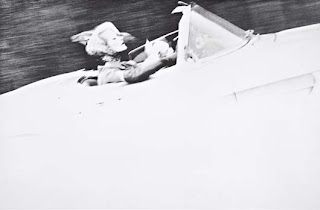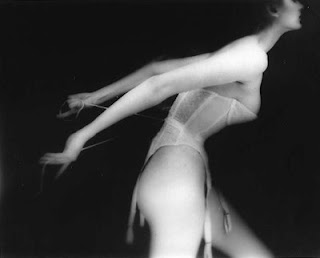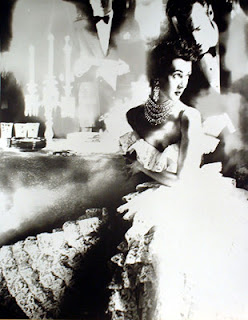Lillian Bassman (1917-2012)
Last Monday, February 13th, the great fashion photographer Lillian Bassman passed away at the age of 94.
In the sea of great fashion photographers (a group that included Cecil Beaton, Richard Avedon, whose work she promoted, Horst P. Horst and Irving Penn) of the mid-twentieth-century or “the golden age of haute-couture” Bassman’s work was strong enough to hold its own. And while there were other female photographers, Louise Dahle-Wolfe comes to mind here, Bassman was an original.
Looking back at Bassman’s work I am struck by how romantic and sensual it is. Her photographs, mostly black and white, more closely resemble paintings then they do photographs. Even when photographing a model in a speeding car, the image is still soft.
 |
| Lillian Bassman, Touch of Dew, New York, 1961 |
Of her work, Bassman told B&W magazine in 1994, “I was interested in developing a method of printing on my own, even before I took photographs. I wanted everything soft edges and cropped.” She was interested, she said, in “creating a new kind of vision aside from what the camera saw.” This vision was achieved by bleaching and blurring the image. The focus no longer was just the famous model, the gorgeous dress, or the romantic setting but all of this elements together made the composition.
 |
| Lillian Bassman, Across the Restaurant, Barbara Mullen, Harper’s Bazaar, 1949 (Plate 20). Image taken from Staley-Wise Gallery. The model Barbara Mullen was Bassman’s muse. |
According to Bassman’s obituary in the New York Times, she was born to Jewish émigrés from Russia in Brooklyn in 1917 but grew up in the Bronx. While attending the Textile High School, she began modeling and worked as an artist’s assistant, later taking night classes at Pratt Institute in Brooklyn. She became acquainted with Alexey Brodovitch who took her on as his apprentice at Harper’s Bazaar, where he was the art director, and later gave her the title of art director at Junior Bazaar. Working with photographers pushed Bassman to explore her own passions and propelled her to step behind the camera lens.
Through out the 1950s, Bassman’s work was in high demand commercially and she also continued to land plum assignments for Harper’s Baazar. Bassman also began to make a name for herself photographing lingerie. Her lingerie work is seductive and bold. As a woman she understood how her subjects wanted to look.
 |
| Lillian Bassman, It’s a Cinch. Carmen, New York, Harper’s Bazaar,1951 (Plate 2). Image taken from Staley-Wise Gallery. |
Bassman became disillusioned with the changing tides in fashion during the 1960s and abandoned fashion photography. She destroyed the negatives of her commercial projects and put her editorial negatives into trash bags which she hid in her home. It wasn’t until the early 1990s when a fashion historian, Martin Harrison, found them in her home and encouraged her to revisit her work. This led to further experimentation with the bleaching process on Bassman’s behalf and a re-awaking of her career. Several exhibitions followed.
The Metropolitan Museum’s Costume Institute featured Bassman’s photo of Dovima in their 2009 exhibition, Model As Muse: Embodying Fashion (see my original review here).
A new book, “Lillian Bassman: Lingerie,” is to be published by Abrams, where Bassman’s son, Eric Himmel is editor in chief, on April 1. Staley-Wise Gallery at 560 Broadway in Soho will have an exhibition of Bassman’s Lingerie photos beginning April 13th. For information visit the gallery website.
As a side note, the exhibition “Cecil Beaton: The New York Years” at the Museum of the City of New York has been extended through April 22nd.
Calendar
| M | T | W | T | F | S | S |
|---|---|---|---|---|---|---|
| 1 | 2 | 3 | 4 | 5 | 6 | 7 |
| 8 | 9 | 10 | 11 | 12 | 13 | 14 |
| 15 | 16 | 17 | 18 | 19 | 20 | 21 |
| 22 | 23 | 24 | 25 | 26 | 27 | 28 |
| 29 | 30 | 31 | ||||
Archives
- June 2018
- March 2018
- December 2016
- January 2016
- November 2015
- September 2015
- August 2015
- June 2015
- March 2015
- February 2015
- December 2014
- November 2014
- October 2014
- May 2014
- April 2014
- January 2014
- December 2013
- November 2013
- October 2013
- September 2013
- June 2013
- May 2013
- April 2013
- March 2013
- February 2013
- December 2012
- November 2012
- October 2012
- September 2012
- August 2012
- July 2012
- June 2012
- May 2012
- April 2012
- March 2012
- February 2012
- January 2012
- December 2011
- November 2011
- October 2011
- September 2011
- July 2011
- June 2011
- May 2011
- April 2011
- March 2011
- February 2011
- January 2011
- December 2010
- November 2010
- October 2010
- September 2010
- July 2010
- June 2010
- May 2010
- April 2010
- March 2010
- February 2010
- January 2010
- December 2009
- November 2009
- October 2009
- September 2009
- August 2009
- July 2009
- June 2009
Categories
- 20th c. design
- Architecture
- Art Deco
- Art Jewelry Forum
- Art Nouveau
- Auction
- Bard Graduate Center
- Blog update
- Brooklyn Metal Works
- Brooklyn Museum
- Ceramics
- Christie's
- Contemporary Art
- Contemporary Design
- Cooper-Hewitt
- Costume Institute
- Decorative Arts Calendar
- Design Exhibition Review
- Designer Spotlight
- Exhibition review
- Extraordinary lives
- Fashion
- Fashion exhibition review
- Fashion photography
- Film
- Fresh Talent
- Furniture
- Gallery Spotlight
- Glass
- ICP NY
- Italian Design
- Jewelry
- Lecture
- MCNY
- Metropolitan Museum of Art
- MoMA
- Museum at F.I.T
- Museum of Arts and Design
- Neue Galerie NY
- On the Market
- Paper Art
- Paris
- Phillips de Pury & Company
- Pinakothek de Moderne
- Platforma
- Public Art
- Rago
- Recently Published Articles
- Russian Decorative Arts
- R|R Gallery
- Sculpture
- Sotheby's
- Television
- Textiles
- Travel
- Uncategorized
- Upcoming Events
- Vintage Clothing
- Wiener Werkstatte
- Wright

Leave a Reply